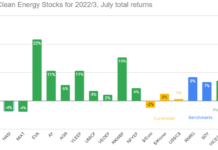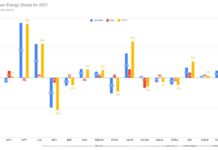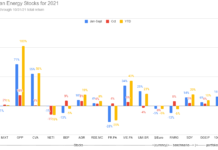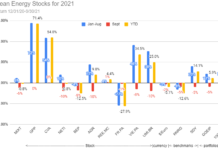Tom Konrad Ph.D., CFA
2015 was a very tough year for energy stocks, especially income oriented energy stocks such as (mostly fossil fuel) MLPs and (mostly clean energy) Yieldcos. Not only did oil and gas prices drop dramatically, but most other commodities did as well. Low commodity prices hurt commodity producers, but also commodity recyclers and efficiency companies that help reduce the consumption.
Against this backdrop, I’m happy that my Ten Clean Energy Stocks for 2015 model portfolio ended the year in the black, with a 5.8% total return from December 31st 2014 to December 31st 2015. For the same period, the broad market of small cap stocks (as measured by the Russell 2000 index ETF IWM) fell 4.8%. The Powershares Wilderhill Clean Energy ETF (NASD: PBW), which is representative of most clean energy stocks, fell 8.3%. My model portfolio is heavy on income stocks (six out of ten), so I also use a clean energy income benchmark. For the year through May, this was the global utilities ETF, JXI, but I switched to the Global X YieldCo Index ETF (NASD:YLCO) at the start of June when it went public. This income benchmark fell 30.4% for the year. I use a 60/40 blend of the income benchmark and PBW for the whole model portfolio, and this benchmark fell 21.6%.
The positive returns were driven by the six income stocks, which were collectively up 23.8%, beating even the Green Global Equity Income Portfolio (GGEIP) which I manage. This was up 12.0% after fees, and still far ahead for the income benchmark. The four value/growth stocks did not fare nearly as well, collectively falling 21.2%, far behind their benchmark, PBW.
Individual Stock Returns and Highlights
Detailed performance for individual stocks can be seen in the chart below (click for a larger version), including performance in the two months since the last update.
At the start of the year, I provided high and low price targets indicating the range in which I expected most of the stocks to finish the year.
As you can see from the following chart, my range predictions were only accurate for half of the stocks, with three income stocks exceeding my high targets, and two value stocks falling below my low targets. I examine the reasons for the two that fell short (Power REIT and MiX Telematics) in the individual stock discussions below.

Income Stocks
1. Hannon Armstrong Sustainable Infrastructure (NYSE:HASI).
12/31/2014 Price: $14.23. Forward Annual Dividend: $1.20. Beta: 0.81. Low Target: $13.50. High Target: $17.
12/31/15 Price: $18.92. 2015 Dividends: $1.08 YTD Total Return: 40.5%.
Sustainable infrastructure financier and Real Estate Investment Trust Hannon Armstrong finally received the investor recognition I’d hoped it would since its IPO in 2013. This recognition drove HASI as high as $21.50 near the height of the Yeildco bubble during the second quarter, and also kept it from crashing back along with its Yieldco cousins.
Also unlike most Yieldcos, Hannon Armstrong retains access to the capital markets, as demonstrated by its secondary offering of stock at $18/share in October and issuance of $100.5 million worth of A-Rated bonds in September.
At a recent Yieldco conference, CEO Jeff Eckel said his goal for the company was to keep boring investors with its predictability. It did just that when the company announced an increase in its quarterly dividend to $0.30 per share, exactly in the middle of its guidance range on December 15th.
HASI remains the largest holding in my managed accounts, but I expect to continue to trim my holdings in the coming year whenever the stock is over $20 to invest in other opportunities.
2. General Cable Corp. (NYSE:BGC)
12/31/2014 Price: $14.90. Forward Annual Dividend: $0.72. Beta: 1.54. Low Target: $10. High Target: $30.
12/31/15 Price: $13.43. 2015 Dividends: $0.72 YTD Total Return: -5.0%.
International manufacturer of electrical and fiber optic cable General Cable Corp. had a volatile year, ending down 5%. In part, that was the normal behavior of a highly leveraged, economically sensitive company in an uncertain economy, but it was also news-driven. The company shot up in the second quarter on buyout rumors, then crashed back when no buyout materialized. The company also ran into a hiccup in its restructuring, when the buyer of its Asian operations, MM Logistics (MML), failed to close on the second part of its purchase.
The company says it is evaluating all its options with regard to MML, but we can expect it to continue to seek buyers for its remaining Asian holdings.
Although I am not selling General Cable in my managed accounts, I have dropped it from the 2016 list because of the high volatility and lack of insider buying.
3. TransAlta Renewables Inc. (TSX:RNW, OTC:TRSWF)
12/31/2014 Price: C$11.48. Forward Annual Dividend: C$0.84. Low Target: C$10. High Target: C$15.
12/31/15 Price: C$10.37. 2015 Dividends: C$0.811 YTD Total C$ Return: -2.6%. YTD Total US$ Return: -18.4%.
Yieldco TransAlta Renewables outperformed most of its troubled Yieldco peers, but still fell for the year. Its decline has only improved its attractive valuation. My dividend discount model values it at C$18.61 at a 9% discount rate, 79% above the year-end price.
Even at the current price, the company is able to access the equity market for capital to acquire new assets and expand the dividend. It just closed on a third drop down from its parent, TransAlta Corp (TAC), which allowed it to increase its per-share annual dividend 5% to C$84.
TransAlta Renewables remains in the list for 2016 because of its compelling 8.1% current yield, and its ability to continue its modest dividend increases in future years.
4. Capstone Infrastructure Corp (TSX:CSE. OTC:MCQPF).
12/31/2014 Price: C$3.63. Forward Annual Dividend C$0.30. Low Target: C$3. High Target: C$5.<
i>
12/31/15 Price: C$3.20. 2015 Dividends: C$0.30 YTD Total C$ Return: 22.8%. YTD Total US$ Return: 2.9%.
Canadian power producer and developer (Yieldco) Capstone Infrastructure rose sharply in November when it announced that it had retained two investment banks to aid it in “reviewing and considering various alternatives involving the Corporation.” A sale of the corporation to a better capitalized buyer could lead to further gains in 2016, but a conclusion of the review without a sale might lead the stock to fall, despite a very attractive 8.3% dividend.
My dividend discount model values Capstone at C$4.89 at a 10% discount rate, and C$3.74 at a 12% discount rate, making Capstone a good to excellent value at its current price. That said, I removed Capstone from the 2016 list to make room for other Yieldcos with even more compelling valuations.
New Flyer Industries (TSX:NFI, OTC:NFYEF).
12/31/2014 Price: C$13.48. Forward Annual Dividend: C$0.70. Low Target: C$10. High Target: C$20.
12/31/15 Price: C$28.32. 2015 Dividends: C$0.557 YTD Total C$ Return: 114.6%. YTD Total US$ Return: 79.9%.
Leading North American bus manufacturer New Flyer ended the year with a bang, rising 42% in the past two months, and 115% for the year in Canadian dollar terms. The rise was due to the recovery of the bus manufacturing industry, and New Flyer’s repeated success in becoming the industry’s clear leader. Over the last two years, New Flyer had consolidated its lead in the transit bus industry with the takeover of rivals NABI and Orion’s parts business. It then announced the merger with the leading motor coach (long distance bus) manufacturer, MCI, and a 12.9% annual dividend increase to C$0.70.
Although I consider New Flyer a great company to own, and excellent diversifier in a green portfolio, I think it’s fully valued at the current price. I have dropped it from the 2016 list and sold roughly two-thirds of the holdings in managed accounts to invest in better valued stocks.
6. Accell Group (XAMS:ACCEL, OTC:ACGPF).
12/31/2014 Price: €13.60. Forward Annual Dividend: TBA. Low Target: €12. High Target: €20.
12/31/15 Price: €21.07. 2015 Dividends: €0.61 YTD Total € Return: 59.4%. YTD Total US$ Return: 43.0%.
European bicycle manufacturer Accell Group has also been consolidating it s position, albeit in a much more fragmented industry. The company’s leadership is particularly strong in the booming European electric bike (e-bike) market. Despite economic headwinds, Accell rode the surging e-bike trend to better revenues and profits in 2015. Like New Flyer, I am dropping Accell from the 2016 list because of its comparatively high valuation and low dividends compared to many Yieldcos. Unlike New Flyer, I have only trimmed my holdings because I believe the e-bike trend will only accelerate.
Value Stocks
7. Future Fuel Corp. (NYSE:FF)
12/31/2014 Price: $13.02. Annual Dividend: $0.24. Beta 0.36. Low Target: $10. High Target: $20.
12/31/15 Price: $13.50. 2015 Dividends: $0.24. YTD Total Return: 5.5%.
Biodiesel and specialty chemicals producer FutureFuel had a turbulent year. The biodiesel market remained depressed because of low oil prices and political uncertainty. Although oil prices have not ceased their decline, the price of biodiesel feedstocks has also fallen, albeit more slowly. When feedstock prices catch up with oil, biodiesel profitability should improve. Low oil prices also increase fuel usage, and hence biofuel demand where regulatory mandates require a certain percentage of fuel sold to be biofuel.
Political uncertainty was greatly reduced when the EPA set target renewable fuel standard (RFS) volumes for 2014, 2015, and 2016 and reinstated the $1-per-gallon tax credit for biodiesel. While ethanol producers were generally unhappy with the new targets, biodiesel producers fared better. All these factors mean 2016 is likely to be a banner year for biodiesel.
While FutureFuel’s biodiesel business stagnated in 2015, its chemicals business recovered from previous missteps. This led to a small positive return for investors in 2015.
While I believe there is still room for improvement in the chemical business, I’m much more optimistic about biodiesel. Hence, I am replacing FF with Renewable Energy Group, a.k.a REG (NASD:REGI) in the 2016 list. REG is the leading pure-play bio-based diesel stock, and it has spent the downturn using its ample balance sheet to buy up weaker rivals, diversify geographically, and consolidate its lead in the industry.
8. Power REIT (NYSE:PW).
12/31/2014 Price: $8.35. Annual Dividend: $0. Beta: 0.52. Low Target: $5. High Target: $20.
12/31/15 Price: $4.35. YTD Total Return: -47.9%.
Solar and rail Real Estate Investment Trust Power REIT received the final ruling in its civil case with its lessees, Norfolk Southern and Wheeling & Lake Erie railways. The main issues in this case were previously resolved in favor of the lessees during summary judgement. Power REIT has hoped to be able to foreclose on the lease of its 112 miles of track, since the value of the lease payments have fallen far below the value of the assets since it was signed in 1967. Although the language of the lease seemed to support Power REIT’s contention that the lessees were in default, the court ruled that past performance under the lease supported the lessees.
The final ruling was decided mostly in Power REIT’s favor. Power REIT’s CEO, David Lesser, was found to have committed fraud in an email as part of the process of creating the holding company Power REIT, and only $1 in damages were awarded. The lessees were unable to prove any damages, and the judge dismissed their attempts to undo the reverse merger by which Power REIT now owns the Pittsburgh & West Virginia Railway (the lease holder.) The court also dismissed the lessees attempts to prevent Power REIT from issuing any more securities.
The remaining legal risks and p
ossible rewards for Power REIT rest on the possibility that Power REIT may appeal. The company has been researching the possibility of an appeal since the unfavorable summary judgment was handed down in August. No decision has yet been made, but Lesser has said me that he believes the cost of an appeal would be limited. While the potential upside from winning an appeal are gigantic, the chances seem low, and so I do not place any value on a potential appeal.
When I came up with my low $5 target below which I did not expect Power REIT’s stock to fall, I had not anticipated the massive decline in Yieldco valuations. Aside from the legal case, Power REIT is a micro-cap Yieldco which owns land under solar farms, and which is likely to resume its $0.40 annual dividend sometime in late 2016 or 2017. On the plus side, the popping of the Yieldco bubble means that Power REIT will have more opportunities to acquire more land under renewable energy projects. Conversely, lower current Yieldco valuations mean that a microcap Yieldco would have to pay a much higher dividend to attract investors. Capstone Infrastructure (discussed above) currently pays an 8.7% dividend. While dividends for Canadian stocks are often higher than US-listed stocks, Power REIT has only 1/30th of the market capitalization of Capstone. Hence a 9% yield seems reasonable, which would give Power REIT a price of $4.44 upon the resumption of the dividend.
Power REIT, while undervalued, is less undervalued than several larger and more liquid Yieldcos. Hence, I am dropping it from the 2016 list. I maintain a position in the common stock in my personal portfolio, and the preferred stock (PW-PA) remains in both my personal and managed portfolios.
9. Ameresco, Inc. (NASD:AMRC).
12/31/2014 Price: $7.00. Annual Dividend: $0. Beta: 1.36. Low Target: $6. High Target: $16.
12/31/15 Price: $6.25. YTD Total Return: -10.7%.
Energy service contractors Ameresco continues to benefit from redoubled efforts to save energy in public buildings.
It had been suffering for two years because its clients, mostly government entities, had been slow to finalize contracts. That has been turning around in 2015, and Obama’s recent initiatives to further improve energy efficiency in government buildings should help as well. Further, Ameresco has diversified its business into commercial solar installation, and that business will benefit over the next few years from the long term extension of the Solar Investment Tax Credit.
Despite all this, the stock fell again in 2015. Company insiders, especially CEO and controlling shareholder George Sakellaris, maintain their faith in the company by continuing to buy the stock in quantity. If other investors fail to recognize Ameresco’s potential in 2016, the stock has fallen low enough that he may decide to take it private.
Ameresco remains in the list for 2016.
Growth Stock
10. MiX Telematics Limited (NASD:MIXT).
12/31/2014 Price: $6.50. Forward Annual Dividend: ZAR 0.08 or $0.15 Beta: 0.78. Low Target: $5. High Target: $20.
12/31/15 Price: $4.22. 2015 Dividends: $0.221 YTD Total South African Rand Return: -8.4%. YTD Total US$ Return: -31.7%.
MiX provides vehicle and fleet management solutions customers in 112 countries. The company’s customers benefit from increased safety, efficiency and security. Like Ameresco, MIXT stock has fallen despite progress in the business, which has been regularly posting annual subscriber growth around 15%.
I attribute the stock decline to a combination of the oil price decline, the fall of the South African rand, and flat earnings caused by falling hardware sales as MiX shifts from a sales model to a bundled subscription model.
The oil price decline hurts MiX because a large proportion of its customers are in the Oil & Gas sector, and the falling rand hurts because South Africa is the company’s home market. Both oil and the rand could go up as easily as down in 2016, having a positive effect on the stock. Also, as more and more of MiX’s revenues come from subscriptions, earnings are becoming less sensitive to hardware sales.
MiX also reinstated its dividend in 2015, a move which did not seem to please the market, but makes it even more attractive to me. The current low valuation and solid finances provide a measure of protection for shareholders even while the company’s strong position in a rapidly growing industry provide excellent long and short term potential.
Even with the falling oil price and rand, I still find the magnitude of MIXT’s fall (and the fact that it fell below my expected range of $5-$20) difficult to explain. When I can’t explain a stock’s fall, I look harder for reasons. When I still can’t explain it, I call it a buying opportunity.
Needless to say, MiX remains in the list for 2016. I have been adding modestly to my position despite considerable losses in the stock over the last two years.
Final Thoughts
2016 holds many risks for the world economy and the stock market. The market remains expensive, despite its small decline in 2015. Growth outside the US seems elusive, and seems especially uncertain in China. On the other hand, clean energy stocks seem particularly undervalued, with most trading at valuations which would interest the most conservative value-oriented investors. In addition to inexpensive valuations, Clean Energy just received important boosts from the historic long term extensions of three important tax credits (the Solar ITC, the wind PTC, and the biodiesel blender’s credit.)
The ITC extension was the longest and is getting the most attention, but it is a little bit of a two-edged sword. Its expected expiration at the end of 2016 has led manufacturers to boost capacity in order to meet an expected demand surge, as projects which might have been built in 2017 or 2018 were expected to be pulled forward to take advantage of the credit. With the ITC extension, these anticipated projects may now be delayed. This, combined with economic weakness in China may cause a temporary glut of solar modules and components. If such a glut emerges, it will damage (already thin) industry profit margins.
I see no such problems for wind or biodiesel. Wind manufacturers (unlike solar) have lived with stop-and-go incentives in the US for the last decade, and so a long-term extension of the PTC should finally allow them the certainty to build out North American manufacturing for the long term. More local manufacturing should drive down costs, setting the stage for a multi-year boom for wind in the US.
Likewise, the biodiesel industry has not had this much regulatory certainty for years. While oil prices are low, feed stock costs are also falling, and regulations have set the stage for industry growth through 2017. Many producers have been driven out of business during the industry downturn, and the survivors are more efficient and have more flexible technology and supply chains than ever before.
Finally, Yieldcos are still widely misunderstood, and so have become extremely cheap. Since the start of the year, worries about China have pulled down the stock market, and many Yieldcos have fallen with it.
Since most Yieldco revenues do not depend on Chinese or even domestic growth, this decline is simply extending what I expect to be a historic buying opportunity for Yieldco stocks.
While I have significant fears about the direction of the broad stock market in 2016, the year could be a first for clean energy stocks. In the past, they have only done well in conjunction with good performance of the broader market, and have sometimes suffered while the broad market held its own. Given the current valuations and strong policy drivers, 2016 could be the first year to see clean energy profits against a backdrop of general market malaise.
Investors hoping to ride the trend should consider this year’s Ten Clean Energy Stocks for 2016.
Disclosure: Long HASI, CSE/MCQPF, ACCEL/ACGPF, NFI/NFYEF, AMRC, MIXT, PW, PW-PA, FF, BGC, RNW/TRSWF. I am the manager of the GGEIP strategy.
DISCLAIMER: Past performance is not a guarantee or a reliable indicator of future results. This article contains the current opinions of the author and such opinions are subject to change without notice. This article has been distributed for informational purposes only. Forecasts, estimates, and certain information contained herein should not be considered as investment advice or a recommendation of any particular security, strategy or investment product. Information contained herein has been obtained from sources believed to be reliable, but not guaranteed.








